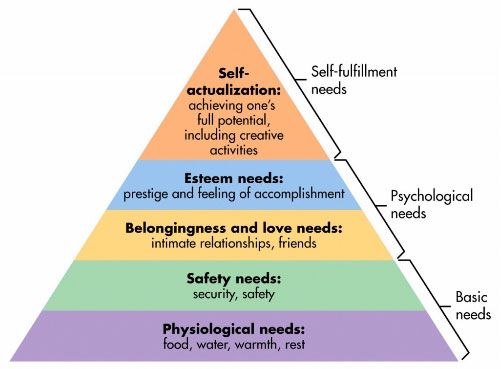The Hierarchy of Needs Theory was proposed by Abraham Maslow in 1943 and well renowned as a classical theory of human motivation. The theory is explained through 5 tiers of human needs as follows.
1. Physiological needs
This is related to the physiological needs are the needs for basic amenities of life. These are the basic needs of air, water, food, clothing, and shelter.
2. Safety needs
Safety needs consist of physical, environmental and emotional safety and protection. To exemplify the needs under this category such as job security, financial security, protection from animals, family security, health security, etc.
3. Social needs
Social needs comprise the need for love, affection, care, belongingness, and friendship.
4. Esteem needs
It includes two types of esteem needs namely internal esteem needs (self- respect, confidence, competence, achievement, and freedom) and external esteem needs (recognition, power, status, attention, and admiration).
5. Self-actualization need
This includes the urge to become what you are capable of becoming or what you have the potential to become. It includes the need for growth and self-contentment. It also includes the desire for gaining more knowledge, social- service, creativity and being aesthetic.

This five stage model of Abraham Maslow can be divided into deficiency needs and growth needs. The first four levels are frequently referred to as deficiency needs (D-needs), and the top level is known as growth or being needs (B-needs).
The deficiency needs are said to motivate people when they are unmet. Also, the need to fulfill such needs will become stronger the longer the duration they are denied.
Before progressing on to meet higher level growth needs, one must satisfy lower level deficit needs. When a deficit need has been satisfied it will go away, and our activities become habitually directed towards meeting the next set of needs that we have yet to satisfy. These then become our most important needs. However, growth needs continue to be felt and may even become stronger once they have been engaged. Once these growth needs have been reasonably satisfied, one may be able to reach the highest level called self-actualization.
Every person is competent and has the longing to move up the hierarchy toward a level of self-actualization. Unfortunately, progress is frequently disrupted by a failure to meet lower level needs and these happen during life experiences, including family economic situation, divorce, trauma, and loss of a job may cause an individual to fluctuate between levels of the hierarchy. Consequently, not everyone will go through the hierarchy in a uni-directional manner. In fact in the reality may move back and forth between the different types of needs.
Our most basic need is for physical survival, and this will be the first thing that motivates our behavior. Once that level is fulfilled the next level up is what motivates us, and so on. Maslow indicated only one in a hundred people become fully self-actualized because our society rewards motivation primarily based on esteem, love and other social needs. Maslow stated that people are motivated to achieve certain needs and that some needs take priority over others.
More from my site






